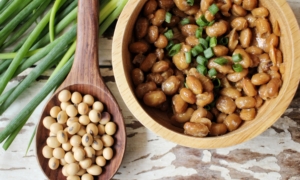Vinegar, considered a culinary staple, is used in salad dressings, chutneys, sauces, marinades, and more. It also delivers medicinal and health benefits.
Vinegar has been used as a seasoning in China for centuries and was known as “bitter wine.” The “Rites of Zhou,” (Zhouli), an ancient Chinese text, contains records of vinegar-making, indicating that its production existed as early as the Zhou dynasty.
The word vinegar originates from the French “vin aigre,”—“vin” meaning wine and “aigre” meaning sour—defining vinegar as sour wine. Regions known for wine production also tend to have a thriving vinegar industry.
The Making of Vinegar
In ancient China, various types of vinegar were used for consumption, including rice vinegar, grain vinegar, koji vinegar, dregs vinegar, tartary buckwheat vinegar, peach vinegar, grape vinegar, and jujube vinegar. However, the ancient Chinese believed that only rice vinegar aged for two to three years could be used as medicine.
The process for producing rice vinegar can generally be divided into the following steps:
- First, steaming the raw rice and adding koji mold, which propagates to form rice koji. Water and the steamed rice are then added to the mixture, which is stirred and maintained at a specific temperature to turn the starch into glucose.
- Yeast is added to the mixture for alcoholic fermentation, converting the glucose into alcohol to produce saké.
- Alcohol is added depending on the desired concentration, and once it reaches the necessary level, cultured acetic acid bacteria are introduced for fermentation, converting the saké into vinegar.
- After the acetic acid fermentation is complete, the vinegar is transferred into barrels to age for two to three months. During this aging process, the sharp odor mellows, and the vinegar develops a rich, aromatic flavor.
- The aged vinegar is then filtered, pasteurized, and bottled.
Be Aware of ‘Imitation’ Vinegar
Imitation or synthetic vinegars are made using petrochemicals or fossil fuels and do not contain the same nutrients as naturally fermented vinegar.
How to Distinguish Between Synthetic and Natural Vinegar
Generally speaking, you can distinguish between synthetic vinegar and naturally fermented vinegar using the following criteria:
- Vinegar with a strong, pungent smell that irritates the nose or tongue is more likely to be synthetic.
- Products that emphasize natural fermentation for over a year are mostly pure naturally fermented vinegar.
- When comparing vinegars of the same volume, pure naturally fermented vinegar is generally priced at around two to three times that of synthetic vinegar.
- If distinguishing between the two remains challenging, it is advisable to simply opt for a well-established, reputable brand.
Health Benefits of Vinegar and Soybeans
Soybeans and vinegar are both beneficial for cardiovascular health.
Research has found that the bioactive peptides in soybeans offer various positive benefits, including lowering blood lipids, reducing blood pressure, and providing anti-inflammatory and antioxidant effects. Additionally,
studies have shown that acetic acid, found in vinegar, can help lower blood pressure.
Vinegar-soaked black soybeans are a part of traditional Chinese culinary and medicinal practices, commonly utilized for their health benefits, particularly in managing hypertension. This traditional remedy is thought to benefit heart health due to its potential effects on blood pressure. The soaking of black soybeans in vinegar not only enhances their flavor but may also increase their nutritional and medicinal value, making them a popular choice for those seeking natural hypertension treatments.
One of my hypertensive patients’ blood pressure became more stable after consuming soybeans with vinegar. What’s more, the study also found that soybean products have a good effect on inhibiting constipation. It is recommended to eat homemade soybeans with vinegar daily for lowering blood pressure and relieving constipation. You can start with five soybeans per day and gradually increase to 10 daily once you are accustomed to them.
Soybeans With Vinegar
Ingredients:
- 20.29 fluid ounces (600 milliliters) of rice vinegar, brown rice vinegar, or grain vinegar
- 7.05 ounces (200 grams) of soybeans
Preparation:
- Place the vinegar and unwashed soybeans into a wide-mouth jar. Cover the jar and let it sit at room temperature for four days. The soybeans will absorb the vinegar and become soft and tender.
- On the fifth day, transfer the jar to the refrigerator. Serve using a clean utensil.
Notes:
- After eating the soybeans, the residual vinegar may lose some of its flavor due to the astringency of the soybeans. It is best to discard it.
- Washing soybeans with water can cause them to spoil more quickly. It is recommended to use organic soybeans and soak them directly without washing.
Simple Homemade Fruit Vinegar
- Wash and dry 2.2 pounds (1 kilogram) of your favorite fruits, such as lemons, grapes, kumquats, or strawberries.
- Place washed fruit in a wide-mouth jar with rock sugar or granulated sugar (to taste).
- Add 1 liter of naturally brewed rice vinegar.
- Store the jar in a dark place and gently stir once a day starting the second day. After a week, remove the fruits from the jar, and the fruit vinegar is ready to be used. Store the fruit vinegar in the refrigerator for use whenever desired.














